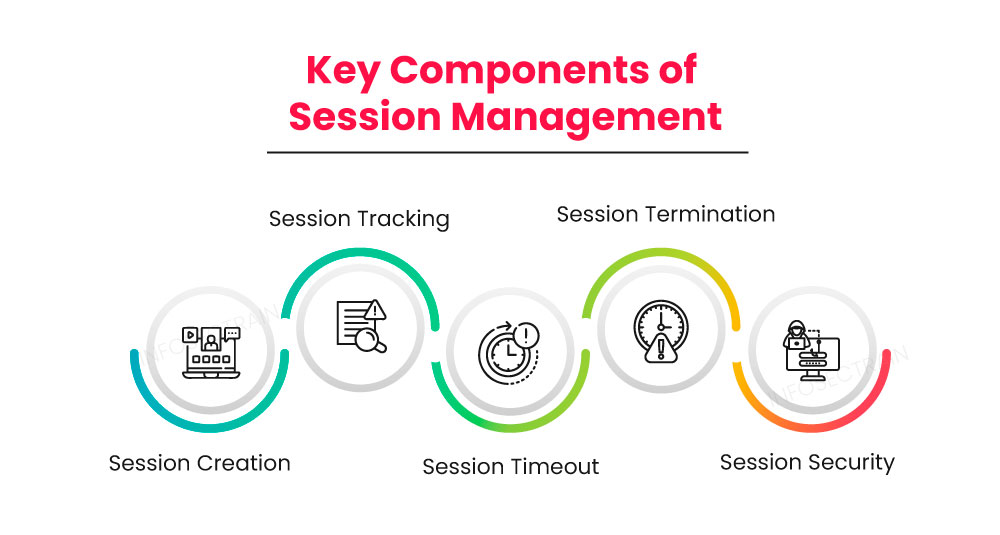Session in Nest JS: Managing sessions in NestJS involves storing and maintaining user-specific data across multiple requests, which is crucial for implementing features like authentication, user preferences, and shopping carts. Here’s a comprehensive guide on managing sessions in NestJS, including the use of libraries like Express-session and Redis for session storage.

Sessions in NestJS :NestJS is a progressive Node.js framework designed for building efficient, reliable, and scalable server-side applications. One crucial aspect of modern web applications is managing sessions to track user activity, preferences, and authentication. In this guide, you’ll learn how to effectively manage sessions in a NestJS application, including best practices, security considerations, and integration with Redis for improved performance.
Table of ContentsSession in NestJS
1. What Is a Session?
A session is a way to store data for individual users on the server-side. This data persists across multiple requests from the same user, typically identified by a session ID stored in a cookie.
Here’s an SEO-friendly article on Managing Sessions in NestJS:
A session is a way to store user-specific data on the server across multiple requests. Sessions are particularly useful for:
- Authentication: Keeping users logged in across requests.
- User Preferences: Persisting settings like themes or language.
- Shopping Carts: Storing items a user adds to their cart during an e-commerce transaction.
In a NestJS application, sessions are typically stored server-side and linked to the client using a session ID, often stored in a browser cookie.

2. Key Concepts
a. Session Store
A session store is where session data is saved. Common options include:
- In-memory (for development, not recommended for production).
- Redis (recommended for production due to performance and persistence).
- Database (e.g., MongoDB, PostgreSQL).
b. Session Middleware
Middleware processes each request and ensures the session data is available.
3. Setting Up Sessions in NestJS
Step 1: Install Required Packages
Install the necessary dependencies:
npm install express-session @nestjs/platform-express
npm install connect-redis ioredis # For Redis support
Step 2: Configure express-session
Use the express-session middleware to manage sessions.
Minimal Setup:
In your main.ts:
import { NestFactory } from '@nestjs/core';
import { AppModule } from './app.module';
import * as session from 'express-session';
async function bootstrap() {
const app = await NestFactory.create(AppModule);
app.use(
session({
secret: 'your-secret-key', // Replace with a secure key
resave: false,
saveUninitialized: false,
cookie: { secure: false }, // Set `true` if using HTTPS
}),
);
await app.listen(3000);
}
bootstrap();
4. Using Redis for Session Storage
Using an in-memory store is not suitable for production because sessions are lost on server restarts. Redis is a fast, persistent key-value store ideal for session management.
Step 1: Install Redis and Dependencies
Install Redis and the required libraries:
npm install connect-redis ioredis
Step 2: Configure Redis Store
Modify main.ts to use Redis:
import { NestFactory } from '@nestjs/core';
import { AppModule } from './app.module';
import * as session from 'express-session';
import * as connectRedis from 'connect-redis';
import Redis from 'ioredis';
async function bootstrap() {
const app = await NestFactory.create(AppModule);
const RedisStore = connectRedis(session);
const redisClient = new Redis();
app.use(
session({
store: new RedisStore({ client: redisClient }),
secret: 'your-secret-key',
resave: false,
saveUninitialized: false,
cookie: { secure: false }, // Set `true` for HTTPS
}),
);
await app.listen(3000);
}
bootstrap();
5. Accessing and Modifying Session Data
Session data can be accessed and modified through the req.session object.
Example: Controller to Use Session
import { Controller, Get, Req, Res } from '@nestjs/common';
import { Request, Response } from 'express';
@Controller('auth')
export class AuthController {
@Get('login')
login(@Req() req: Request, @Res() res: Response): string {
// Save user data to the session
req.session.user = { id: 1, username: 'john_doe' };
return 'User logged in, session updated!';
}
@Get('profile')
profile(@Req() req: Request): string {
// Access session data
if (req.session.user) {
return `Hello, ${req.session.user.username}`;
}
return 'No user logged in!';
}
@Get('logout')
logout(@Req() req: Request, @Res() res: Response): string {
// Destroy the session
req.session.destroy((err) => {
if (err) {
res.status(500).send('Could not log out.');
} else {
res.send('Logged out successfully!');
}
});
return '';
}
}
6. Session Security
a. Secure Cookies
Enable secure cookies in production:
cookie: { secure: true, httpOnly: true, maxAge: 3600000 }, // 1 hour
b. Environment Variables
Store sensitive configuration like secret in environment variables.
c. CSRF Protection
Use libraries like csurf for Cross-Site Request Forgery protection.
7. Advanced Features
a. Custom Middleware for Session Initialization
You can create middleware to customize session handling.
Example:
import { Injectable, NestMiddleware } from '@nestjs/common';
import { Request, Response, NextFunction } from 'express';
@Injectable()
export class SessionMiddleware implements NestMiddleware {
use(req: Request, res: Response, next: NextFunction) {
if (!req.session.views) {
req.session.views = 0;
}
req.session.views++;
console.log(`View count: ${req.session.views}`);
next();
}
}
Register it in your AppModule:
import { Module, MiddlewareConsumer } from '@nestjs/common';
import { AppController } from './app.controller';
import { AppService } from './app.service';
import { SessionMiddleware } from './session.middleware';
@Module({
imports: [],
controllers: [AppController],
providers: [AppService],
})
export class AppModule {
configure(consumer: MiddlewareConsumer) {
consumer.apply(SessionMiddleware).forRoutes('*');
}
}
8. Storing Session Data in a Database
You can also use databases like MongoDB or PostgreSQL to store sessions using libraries like connect-mongo or connect-pg-simple.
Using MongoDB:
Install the dependencies:
npm install connect-mongo
Update main.ts:
import * as session from 'express-session';
import * as connectMongo from 'connect-mongo';
import mongoose from 'mongoose';
const MongoStore = connectMongo(session);
mongoose.connect('mongodb://localhost:27017/nest-session');
app.use(
session({
store: new MongoStore({ mongooseConnection: mongoose.connection }),
secret: 'your-secret-key',
resave: false,
saveUninitialized: false,
}),
);
9. Testing and Debugging
a. Testing Session Behavior
Use tools like Postman or curl to test session functionality.
b. Debugging Sessions
Enable debug logs for session middleware:
DEBUG=express-session npm run start
10. Scaling Session Management
a. Session Replication
In distributed systems, ensure sessions are stored in a centralized system like Redis.
b. Sticky Sessions
For load-balanced setups, ensure sticky sessions are enabled to route subsequent requests to the same server.
11. Final Considerations
- Session Expiry: Define
maxAgefor cookies to control session lifespan. - Session Regeneration: Regenerate sessions after login to prevent session fixation attacks.
- Memory Store: Avoid using the default in-memory store in production.
By following these guidelines, you can effectively manage sessions in a NestJS application, ensuring scalability, security, and seamless user experiences.



